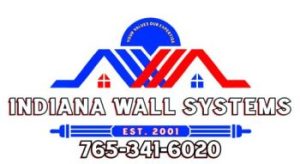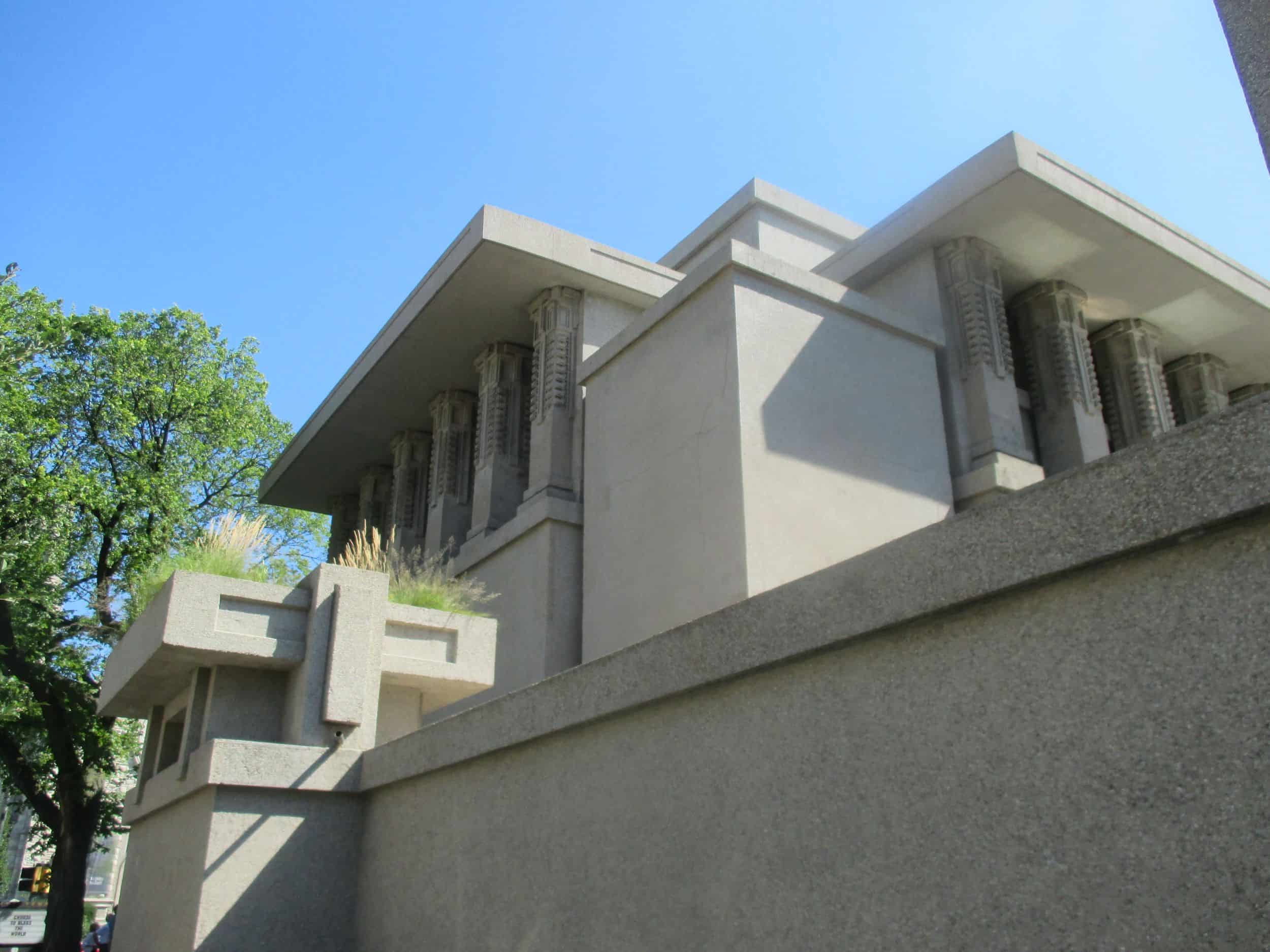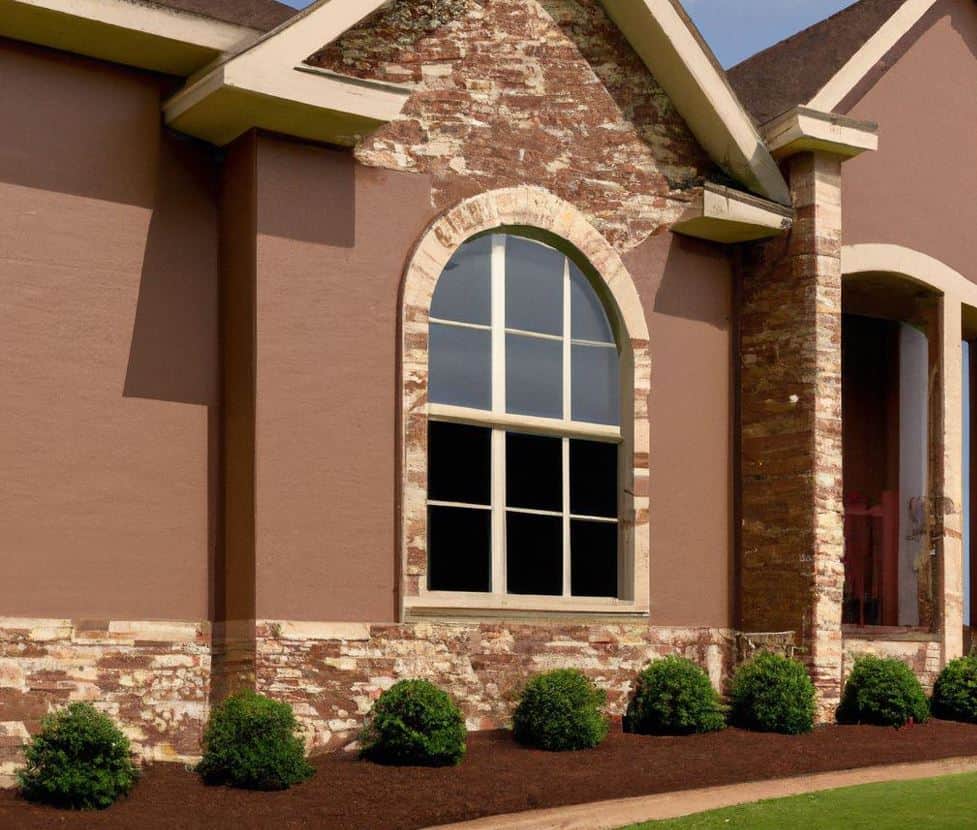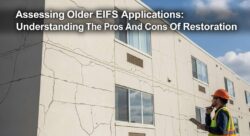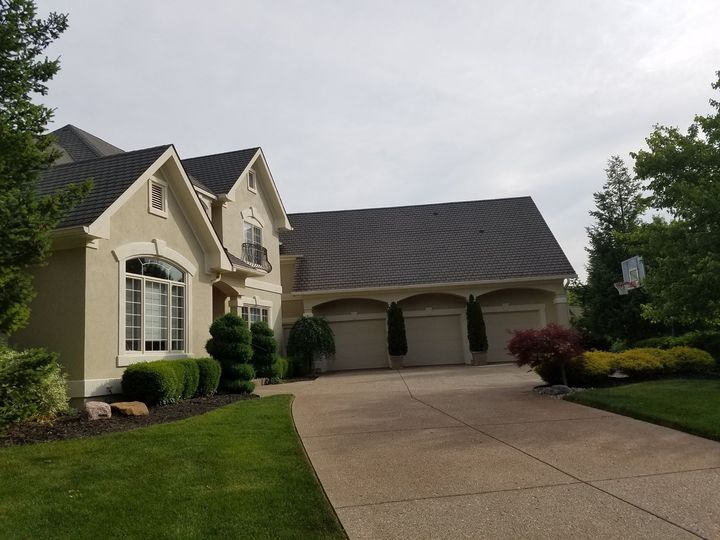Catch Hidden Winter Damage Before It Costs You Thousands—Discover Indiana’s Exact Spring Inspection Schedule to Keep Your EIFS Cladding Strong, Dry, and Worry-Free.
After a harsh Indiana winter, your home’s exterior has battled freezing temperatures, snow, ice, and dramatic temperature swings. That’s why spring is the perfect time to check on your EIFS (Exterior Insulation and Finish System) cladding – often called synthetic stucco – to catch any winter damage before it turns into expensive summer repairs.
As someone who’s been inspecting, repairing, and installing EIFS for over two decades here in Indiana, I’ve seen firsthand how our unique climate challenges these systems. At Indiana Wall Systems, we’ve learned that timing your EIFS inspections correctly can mean the difference between a simple, affordable repair and a complete system overhaul.
Indiana’s freeze-thaw cycles are particularly harsh on exterior cladding systems. We can see temperatures swing from below freezing to 50°F in a single day – sometimes multiple times in a week! These dramatic shifts put enormous stress on your EIFS, especially around joints, penetrations, and transitions. When moisture finds its way in during these cycles, it can remain hidden until warmer weather arrives, which is exactly why spring inspections are critical for Indiana homeowners.
Key Takeaways
- EIFS should be professionally inspected at least once per year in Indiana’s climate, ideally in early spring
- Winter freeze-thaw cycles can create hidden moisture problems that become visible only after temperatures rise
- Different EIFS systems (barrier vs. water-managed) require different inspection approaches and frequencies
- DIY visual inspections should be performed quarterly, focusing on sealants, joints, and vulnerable areas
- Professional EIFS inspections in Indiana typically cost $350-$750 depending on home size and complexity
Impact of Seasonal Changes in EIFS Wall Systems
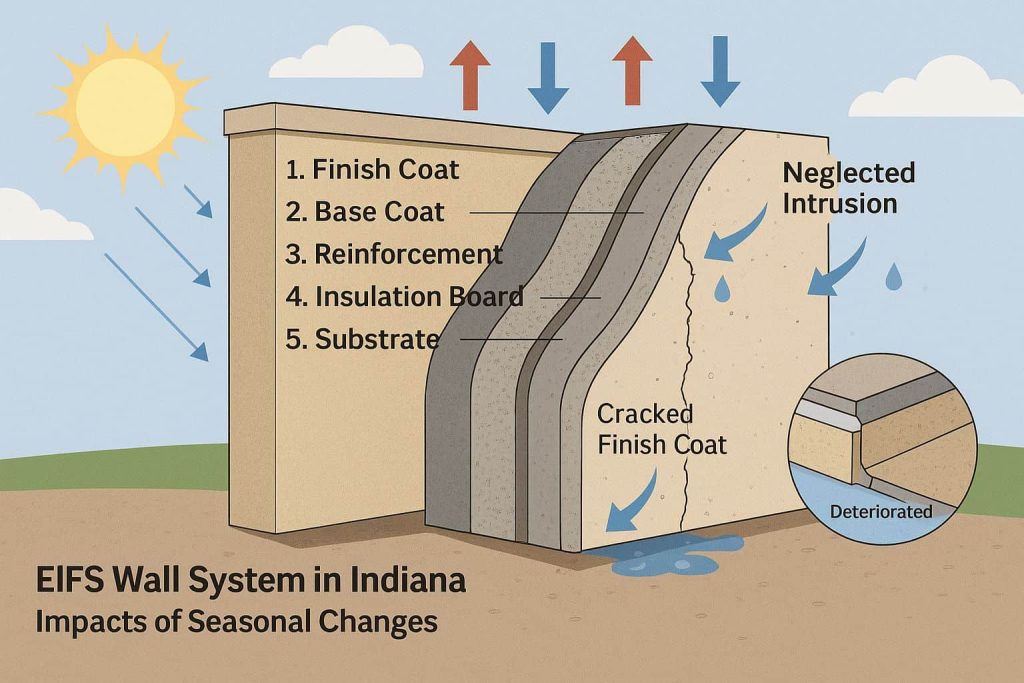
Why EIFS Inspection Timing Matters in Indiana
In my 22 years of EIFS experience throughout Indiana, I’ve seen too many homeowners wait until summer to check their systems, only to discover that minor winter damage had already developed into major issues.
Our Indiana climate presents unique challenges for EIFS:
- Harsh freeze-thaw cycles (sometimes multiple in a single week)
- Heavy spring rains following winter ice dam formation
- Dramatic temperature swings in March and April
- High humidity during seasonal transitions
These climate factors can stress your EIFS system in ways that may not show immediate visible damage but create perfect conditions for moisture intrusion. By spring, this moisture begins to cause problems that a timely inspection could have prevented.
The physics behind this is straightforward: when water freezes, it expands by about 9%. If moisture has penetrated even the tiniest crack in your EIFS, this expansion can widen the crack from within. As this process repeats throughout winter, what started as a hairline crack can become a significant entry point for more moisture. Once temperatures warm in spring, this accumulated moisture becomes active – potentially causing damage to your substrate, insulation, and even interior walls.
Understanding EIFS Inspection Frequency: The Indiana Schedule
Different EIFS types require different inspection approaches and schedules. Here’s what we recommend for Indiana homes and buildings:
Barrier EIFS vs. Water-Managed EIFS
If you’re unsure which type you have, here’s a quick way to identify your system:
Barrier EIFS vs. Water-Managed EIFS
Barrier EIFS was the standard installation before the early 2000s. These systems rely entirely on the outer surface seal to keep moisture out. If your home was built before 2000 and has never had its EIFS replaced, you likely have a barrier system, which requires more frequent inspections.
Water-managed EIFS includes a dedicated drainage plane that allows any moisture that penetrates the surface to escape. While still requiring regular inspection, these modern systems are more forgiving of minor damage.
A quick rule of thumb: if you see small weep holes or drainage openings at the bottom of your EIFS installation, you likely have a water-managed system. If there are no visible drainage features, you probably have a barrier system requiring more vigilant maintenance.
How Indiana Seasons Affect EIFS Performance
Each season brings different challenges for your EIFS system:
EIFS Inspection Frequency in Indiana
Winter: Freeze-thaw cycles create expansion and contraction stresses. Ice dams can force moisture under flashings. Snow buildup against walls can introduce excess moisture.
Spring: Rapid temperature changes and heavy rains test the system’s integrity. Previously frozen moisture becomes active and can reveal hidden damage.
Summer: UV exposure and heat can degrade sealants faster. High humidity can slow the evaporation of any trapped moisture.
Fall: Temperature drops create new contraction stresses. Falling leaves and debris can block drainage channels if not cleared.
This seasonal cycle explains why spring inspections catch winter damage before summer humidity can amplify problems. Our experience shows that addressing EIFS issues in April or May often costs 60-70% less than fixing the same problems that have worsened by August.
The Ideal Spring Inspection Timeline for Indiana EIFS
Based on our experience with hundreds of EIFS projects throughout central Indiana, here’s the ideal inspection timeline:
Early Spring (March-April)
This is the most critical inspection of the year. Schedule a professional assessment once daytime temperatures consistently reach above 45°F. Why this timing matters:
- Winter damage is fresh and easier to repair
- Moisture that entered during freeze-thaw cycles becomes visible
- Repairs can be completed before heavy spring rains
- Allows time to dry out any moisture before summer humidity
At Indiana Wall Systems, we see a 30% increase in detectable EIFS issues during early spring inspections compared to any other season. This isn’t because more damage occurs in winter, but because existing problems become more visible as temperatures rise.
Mid-Spring Follow-Up (Late April-May)
For homes with barrier EIFS or those that showed minor issues during early spring inspection:
- Check repair effectiveness after spring rains
- Ensure proper curing of any sealant replacements
- Confirm drainage systems are functioning
- Evaluate landscaping growth near EIFS surfaces
End of Spring Assessment (Late May-Early June)
Before summer heat arrives:
- Verify all repairs have cured properly
- Ensure no new issues have developed
- Prepare the system for summer’s UV exposure
- Clean any pollen or spring debris from drainage features
This three-phase approach provides optimal protection for Indiana homes with EIFS cladding, particularly for older barrier systems that lack integrated drainage capabilities.
Signs Your EIFS Needs Immediate Inspection – Regardless of Season
While spring is ideal, certain warning signs warrant immediate inspection regardless of the calendar:
- Visible cracks in the EIFS surface (particularly around windows and doors)
- Soft spots when you press gently on the surface
- Bubbling or bulging of the finish coat
- Staining or discoloration, especially in patterns suggesting water movement
- Deteriorated sealant around windows, doors, and penetrations
- Interior signs like water stains or musty odors
If you notice any of these signs, don’t wait for spring—contact a certified EIFS inspector immediately.
The Hidden Warning Signs Most Homeowners Miss
Beyond the obvious red flags, watch for these subtle indicators:
- Slight discoloration bands beneath window sills or above flashings
- Small bubbles in the finish coat that feel firm but indicate trapped air
- Spider-web cracking that’s nearly invisible except in certain lighting
- Hollow sounds when tapping gently on the surface (indicates delamination)
- Uneven dirt patterns that may signal moisture movement within the system
- Interior window sill moisture even during dry weather
In our experience, these subtle signs often precede major failures by 3-6 months. Catching them early through regular inspection can save thousands in repair costs.
Professional vs. DIY EIFS Inspections: What Indiana Homeowners Should Know
DIY Visual Inspections (Monthly-Quarterly)
As an Indiana homeowner, you should perform basic visual inspections quarterly, with special attention after major storms or temperature extremes. Focus on:
- Sealant condition around windows, doors, and penetrations
- Joint integrity where EIFS meets different materials
- Surface appearance for cracks, bulges, or staining
- Flashing integrity at roof-wall intersections
- Gutter and downspout function to ensure proper drainage away from EIFS surfaces
Professional Inspections (Annually)
Professional inspections should be conducted at least annually for water-managed systems and semi-annually for barrier systems. A certified EIFS inspector will:
- Use specialized moisture detection equipment
- Check substrate integrity beneath the surface
- Perform thermal imaging to identify hidden moisture
- Assess overall system performance
- Provide documentation for warranty purposes
At Indiana Wall Systems, our professional inspections include moisture meter readings at critical points and thermographic scans when needed. These tools allow us to detect problems invisible to the naked eye.
Equipment Used in Professional EIFS Inspections
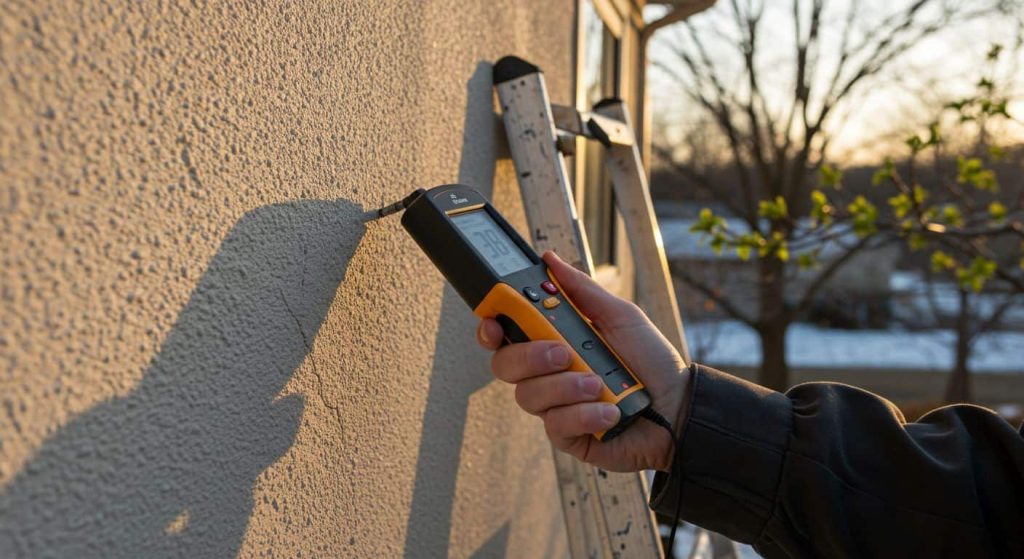
The technology used in professional inspections has evolved significantly in recent years. Modern EIFS inspections utilize:
- Non-invasive moisture meters that can detect moisture without puncturing the surface
- Penetrating moisture probes for confirmation readings at suspicious areas
- Thermal imaging cameras that reveal temperature differences indicating moisture
- Borescopes for visual inspection behind the system in critical areas
- Ultrasonic testing equipment to detect delamination between system layers
This specialized equipment can detect moisture content as low as 15% within the wall system—well before visible damage occurs but after moisture has begun to compromise the system. This early detection capability is why professional inspections consistently deliver a strong return on investment.
The Indiana Spring EIFS Inspection Checklist
After inspecting hundreds of EIFS homes throughout central Indiana, we’ve developed this comprehensive spring inspection checklist.
Spring EIFS Inspection Checklist
A comprehensive guide based on 500+ EIFS inspections by Indiana Wall Systems
Exterior Visual Assessment
- Document all visible cracks with measurements
- Check all expansion joints for integrity
- Inspect termination points at material transitions
- Assess for staining, bulging, or texture changes
Moisture Investigation
- Test moisture at windows, doors, and penetrations
- Take moisture readings in grid pattern
- Focus on previous repair locations
- Listen for hollow sounds indicating delamination
Drainage Assessment
- Verify proper kickout flashing installation
- Check window head flashing for water shedding
- Confirm weep holes are functioning properly
- Ensure proper slope away from foundation
Sealant Inspection
- Check for cracking, hardening, or separation
- Perform gentle pull test at key points
- Verify proper sealant type compatibility with EIFS
- Ensure sufficient flexibility for seasonal movement
Architectural Features
- Inspect aesthetic bands for water trapping details
- Check joints where decorative elements meet wall
- Verify proper flashing at material transitions
- Ensure proper clearance at roof-to-wall interfaces
Environmental Factors
- Check for plants contacting EIFS surfaces
- Verify sprinklers aren’t hitting EIFS walls
- Ensure water moves away from EIFS walls
- Check for UV degradation on south/west exposures
Remember: Professional EIFS inspections in spring can save up to 85% on repair costs compared to addressing problems later in the year.
Ready for your professional EIFS inspection?
Call Indiana Wall Systems today: (765) 341-6020
1. Exterior Visual Assessment
- Crack mapping: Document all visible cracks with measurements
- Joint evaluation: Check all expansion joints for integrity
- Termination points: Inspect where EIFS meets other materials
- Surface condition: Look for staining, bulging, or texture changes
- Impact damage: Assess any damage from winter activities or debris
2. Moisture Investigation
- Critical areas: Test moisture levels at windows, doors, and penetrations
- Pattern testing: Sample moisture readings in grid pattern
- Problem zones: Focus on areas with previous repairs or issues
- Substrate tapping: Listen for hollow sounds indicating delamination
3. Drainage Assessment
- Kickout flashing: Verify proper installation and condition
- Window head flashing: Check for proper shedding of water
- Drainage plane: Confirm weep holes are functioning (in water-managed systems)
- Grade evaluation: Ensure proper slope away from foundation
4. Sealant Inspection
- Deterioration check: Look for cracking, hardening, or separation
- Adhesion test: Gentle pull test at key points
- Compatibility confirmation: Verify proper sealant type for EIFS
- Expansion capacity: Ensure sufficient flexibility for seasonal movement
5. Architectural Feature Evaluation
- Aesthetic bands and projections: Check for water trapping details
- Quoins and decorative elements: Inspect joints where features meet wall
- Transitions between materials: Verify proper flashing and sealing
- Roof-to-wall interfaces: Ensure proper clearance and flashing
6. Environmental Factors Assessment
- Vegetation proximity: Check for plants contacting or too close to EIFS
- Sprinkler spray patterns: Verify sprinklers aren’t hitting EIFS surfaces
- Drainage paths: Ensure water moves away from EIFS walls
- Sun exposure evaluation: Check for UV degradation on south/west faces
7. Previous Repair Verification
- Prior patch integrity: Assess condition of previous repairs
- Color matching: Evaluate whether repairs are still blending properly
- Edge transitions: Check for separation at repair boundaries
- Texture consistency: Confirm repairs still match surrounding finish
This comprehensive approach ensures no aspect of your EIFS system goes unexamined during spring inspection. Each of these categories has proven crucial in our decades of EIFS experience throughout Indiana.
Indiana EIFS Inspection Costs: A Professional Breakdown
Based on current market rates across Indiana, here’s what to expect:
The Cost of Professional EIFS Inspections in Indiana
Based on current market rates across Indiana, here’s what to expect when budgeting for a professional EIFS inspection:
(with moisture mapping)
Early detection through regular inspections typically saves 5-10 times the inspection cost in prevented repairs. Professional EIFS inspections are an investment that helps avoid expensive emergency repairs.
While this might seem significant, consider that early detection through regular inspections typically saves 5-10 times the inspection cost in prevented repairs. For example, we recently inspected a Carmel, IN home that had a small sealant failure around a window. Caught early in our spring inspection, the repair cost was under $300. Had this gone undetected until summer, moisture intrusion would likely have damaged the sheathing and insulation, potentially resulting in a $3,000-5,000 repair.
What’s Included in Different Inspection Packages
Basic Inspection Typically Includes:
- Visual evaluation of all EIFS surfaces
- Moisture meter readings at high-risk areas
- Basic report with findings and recommendations
- Limited photo documentation
- Identification of immediate concerns
Comprehensive Inspection Adds:
- Thermal imaging of entire EIFS system
- Systematic moisture mapping of all walls
- Detailed documentation of all conditions
- Comprehensive digital report with images
- Prioritized action plan with timelines
- Follow-up consultation on findings
For most Indiana homes, we recommend the comprehensive inspection at least every other year, with basic inspections in between. This approach provides thorough documentation while managing costs effectively.
Special Considerations for Different Indiana Regions
Indiana’s diverse geography creates unique EIFS challenges depending on your location. Our extensive experience throughout the state has shown that inspection needs and common issues vary significantly by region.
EIFS Climate Regions in Indiana
Northern Indiana
Primary Challenge: Lake effect snow
Key Focus: Frequent freeze-thaw cycles
Recommended Inspections: 2-3 per year
Central Indiana
Primary Challenge: Clay soil expansion
Key Focus: Rapid weather changes
Recommended Inspections: 1-2 per year
Johnson County
Primary Challenge: Urban/rural transition
Key Focus: Landscaping interfaces
Recommended Inspections: 1 per year + moisture mapping
South Central Indiana
Primary Challenge: Higher humidity
Key Focus: Organic growth prevention
Recommended Inspections: 1 per year + frequent cleaning
Southern Indiana
Primary Challenge: Ohio River Valley climate
Key Focus: Constant humidity management
Recommended Inspections: 1-2 per year with humidity focus
Northern Indiana
Key Areas: South Bend, Fort Wayne, Columbia City
Regional EIFS Challenges:
- Lake effect snow creates heavier accumulations against EIFS surfaces
- More frequent freeze-thaw cycles from lake-influenced weather patterns
- Higher overall moisture exposure requires special attention to drainage details
- Reduced winter drying time due to lower sun angles and shorter days
Inspection Recommendations:
- Professional inspections twice yearly (early spring and fall)
- More frequent sealant evaluations, especially on north-facing walls
- Special attention to roof-wall interfaces where ice dams form
- Increased focus on kickout flashing performance
Central Indiana / Greater Indianapolis Area
Key Areas: Indianapolis, Carmel, Fishers, Zionsville, Speedway, Plainfield, Avon, Mooresville, Camby
Regional EIFS Challenges:
- Clay soil expansion creates foundation movement that stresses EIFS
- Urban heat island effect accelerates UV degradation of sealants and finishes
- Moderate but highly variable conditions with rapid weather changes
- Higher urban pollution levels can stain and degrade EIFS finishes
Inspection Recommendations:
- Annual professional inspection in early spring
- Quarterly homeowner visual checks
- Special attention to lower portions near expanding clay soils
- More frequent cleaning in urban areas to prevent pollution buildup
Johnson County Area
Key Areas: Greenwood, Franklin, Bargersville, Whiteland, Trafalgar, Nineveh, Edinburgh
Regional EIFS Challenges:
- Transition zone between urban and rural environments
- Higher percentage of residential EIFS applications
- More landscaping contact with EIFS surfaces
- Variable drainage conditions across developing areas
Inspection Recommendations:
- Annual professional inspections with detailed moisture mapping
- Special attention to grade changes and landscaping interfaces
- Increased focus on vegetation management around EIFS
- Particular care for homes near waterways and flood plains
South Central Indiana
Key Areas: Bloomington, Columbus, Bedford, Seymour, North Vernon
Regional EIFS Challenges:
- Higher average humidity affects drying times and moisture dynamics
- More tree coverage increases organic debris contact with EIFS
- More acidic soil composition in certain areas can affect lower wall sections
- Rolling terrain creates unique water drainage challenges
Inspection Recommendations:
- Annual inspection with emphasis on humidity-related issues
- More frequent cleaning to prevent mold and mildew growth
- Special attention to hillside properties with grade changes
- Enhanced focus on gutter performance and roof runoff
Southern Indiana
Key Areas: Scottsburg, Crothersville, Austin, Clarksville, Jeffersonville
Regional EIFS Challenges:
- Longer growing season means more vegetation management
- Higher annual rainfall increases moisture exposure
- Less severe freeze-thaw cycles but more constant humidity
- Ohio River Valley climate influences create unique moisture patterns
Inspection Recommendations:
- Annual professional inspection with specialized humidity considerations
- More frequent cleaning due to higher organic growth potential
- Enhanced focus on proper ventilation behind EIFS
- Special attention to historic building applications
Kentucky Border Region
Key Areas: Louisville area, Sellersburg
Regional EIFS Challenges:
- Ohio River Valley humidity creates persistent moisture concerns
- More extreme summer heat accelerates UV degradation
- Cross-border code variations may affect system specifications
- Higher occurrence of urban heat island effects in metro areas
Inspection Recommendations:
- Annual professional inspections with thermal imaging
- Enhanced UV protection considerations
- More frequent sealant evaluations due to heat expansion/contraction
- Special attention to historic building applications
These regional variations highlight why local expertise matters when inspecting EIFS in Indiana. At Indiana Wall Systems, we’ve developed specific inspection protocols for each region based on two decades of performance data and weather pattern analysis.
Regional Moisture Patterns in Indiana
Our moisture mapping data from thousands of inspections reveals interesting regional patterns:
Northern Indiana EIFS homes typically show more moisture issues at the top third of walls due to ice dam effects and roof-wall interfaces.
Central Indiana installations tend to develop problems around the lower portions where clay soil expansion during wet periods can create stress on the system.
Southern Indiana properties often show more uniform moisture distribution but higher overall readings due to the region’s higher ambient humidity.
These regional differences highlight why local expertise matters when inspecting EIFS in Indiana. At Indiana Wall Systems, our inspectors are trained to recognize these regional patterns and adjust their assessment approach accordingly.
What Happens During a Professional Spring EIFS Inspection in Indiana
When you schedule a professional inspection with Indiana Wall Systems, here’s our proven process:
1. Exterior Assessment
We begin with a thorough visual examination, documenting all visible conditions through high-resolution photography and detailed notes. We pay special attention to:
- Areas around windows and doors
- Roof-wall intersections
- Deck attachments
- Utility penetrations
- Previous repair locations
2. Moisture Detection
Using calibrated moisture meters, we test at-risk areas and perform a systematic grid pattern of readings to create a comprehensive moisture map. Our equipment can detect moisture within the system before visible damage appears.
3. Thermal Imaging
For more complex investigations, we employ infrared thermal imaging to identify temperature differentials that may indicate hidden moisture or insulation issues.
4. Sealant Evaluation
We inspect all sealant joints, assessing:
- Current condition
- Proper installation
- Compatibility with EIFS
- Expected remaining lifespan
5. Documentation and Recommendations
You’ll receive a detailed report including:
- Moisture readings map
- Photographic documentation
- Specific recommendations with prioritized action items
- Cost estimates for any needed repairs
6. Maintenance Planning
Based on our findings, we’ll help you develop a customized maintenance plan that includes:
- Prioritized repair schedule
- Preventive maintenance recommendations
- Future inspection timeline
- Budget planning for long-term care
This systematic approach ensures no aspect of your EIFS system goes unexamined and provides a clear roadmap for maintaining your home’s exterior for years to come.
DIY Spring EIFS Maintenance Tips for Indiana Homeowners
Between professional inspections, here are steps every Indiana homeowner should take to maintain their EIFS:
1. Post-Winter Visual Inspection
Once temperatures consistently reach above 45°F, conduct a thorough visual inspection:
- Check for new cracks or expanded existing cracks
- Look for staining patterns that may indicate water movement
- Assess sealant condition around all penetrations
- Examine flashing integrity at roof edges and transitions
2. Gentle Cleaning
Spring is the ideal time to clean your EIFS surface:
- Use gentle low-pressure water (never power washing)
- Apply an EIFS-approved cleaner for stubborn stains
- Remove any algae or mildew growth with appropriate treatments
- Keep sprinklers adjusted away from EIFS surfaces
3. Vegetation Management
Spring growth should be managed to protect your EIFS:
- Trim shrubs and trees to maintain at least 12″ clearance
- Remove climbing plants that can damage the finish coat
- Clear debris from the base of walls to prevent moisture transfer
4. Gutter Maintenance
Functioning gutters are essential for EIFS protection:
- Clean all gutters and downspouts
- Verify proper flow away from foundation
- Check for leaks at gutter seams near EIFS surfaces
- Install splash blocks if needed
5. Simple Moisture Testing
While not as accurate as professional equipment, homeowners can perform basic moisture checks:
- Feel for soft spots by applying gentle pressure to the EIFS surface
- Look for surface temperature differences after rain (dry areas warm faster)
- Check interior walls and trim adjacent to EIFS for signs of moisture
- Monitor humidity levels in rooms with exterior EIFS walls
6. Document and Track
Maintain a simple record of your observations:
- Take dated photos of any areas of concern
- Keep notes on when issues first appear
- Track changes in condition over time
- Save all professional inspection reports for comparison
This documentation can be invaluable for professional inspectors and can help establish patterns that aid in diagnosing complex issues.
Common Post-Winter EIFS Problems in Indiana Homes
Based on over two decades of spring inspections across Indiana, here are the most common issues we discover:
1. Sealant Failures
Indiana’s freeze-thaw cycles are particularly hard on sealants. We find that 60% of moisture problems begin with sealant failures that developed during winter.
2. Hairline Cracks
Thermal expansion and contraction often create small cracks during winter. While seemingly minor, these openings can allow moisture penetration if not addressed promptly.
3. Impact Damage
Winter activities and ice removal efforts often cause unnoticed impact damage. These divots and depressions become collection points for moisture.
4. Delamination
Freeze-thaw cycles can sometimes cause the EIFS layers to separate (delaminate), particularly in older barrier systems. This condition requires immediate attention.
5. Flashing Failures
Ice dams and heavy snow loads can compromise flashing integrity, creating entry points for water as spring rains arrive.
6. Mechanical Fastener Issues
The expansion and contraction from freeze-thaw cycles can loosen mechanical fasteners, particularly in older systems or those with accessories attached to the EIFS surface.
7. Insulation Compression
Snow weight and ice formation can compress the EPS insulation board in some installations, creating depressions that collect water rather than shedding it properly.
8. Termination Point Separation
Where EIFS meets other materials, winter movement often creates separation, particularly at window frames, door jambs, and trim pieces.
Our repair data shows that addressing these issues in early spring costs an average of 40-60% less than waiting until they worsen in summer. For example, a typical sealant replacement in April costs $8-12 per linear foot, while the same repair plus associated water damage in July averages $20-30 per linear foot.
EIFS Inspection Case Study: Indianapolis Townhome Complex
In spring 2024, we conducted comprehensive inspections of a 28-unit townhome complex in Indianapolis with 15-year-old water-managed EIFS. Our findings illustrate the importance of spring inspections:
- 12 units (43%) had sealant failures around windows
- 8 units (29%) showed elevated moisture readings despite no visible damage
- 5 units (18%) had minor impact damage from winter activities
- 3 units (11%) displayed cracking at stress points
By addressing these issues immediately after detection, the homeowners’ association avoided an estimated $87,000 in potential summer repair costs. The total cost for all necessary repairs was approximately $28,500 – representing significant savings through early intervention.
Clear Breakdown of Repair Costs
Detailed Repair Costs Breakdown
(Spring)
to Summer
This case study demonstrates the dramatic cost difference between proactive spring repairs and delayed intervention. The key factor was catching moisture intrusion before it could spread within the wall system.
Highest Risk Issue
Hidden moisture problems show the largest cost escalation (364%) when repairs are delayed from spring to summer.
Cost-Effective Timing
Early spring inspection identified 28 repair issues, saving an average of $3,155 per unit compared to summer repairs.
This case study demonstrates the dramatic cost difference between proactive spring repairs and delayed intervention. The key factor was catching moisture intrusion before it could spread within the wall system.
Long-Term Inspection and Maintenance Planning for EIFS Longevity
A well-maintained EIFS system can last 30+ years in Indiana’s climate. Here’s our recommended long-term inspection and maintenance schedule based on system type:
Water-Managed EIFS Systems
Year 1-5 after installation:
- Professional inspection annually in spring
- Homeowner visual checks quarterly
- Cleaning annually
- Sealant touch-up as needed
Years 5-10 after installation:
- Professional inspection annually (spring)
- Moisture mapping every other year
- Homeowner visual checks quarterly
- Cleaning annually
- Comprehensive sealant evaluation at year 7
- Partial sealant replacement typically needed by year 9
Years 10-15 after installation:
- Professional inspection twice yearly (spring and fall)
- Full moisture mapping annually
- Homeowner visual checks monthly during winter/spring
- Cleaning twice annually
- Complete sealant replacement typically needed by year 12-14
- Repair of impact damage as needed
Years 15+ after installation:
- Professional inspection three times yearly
- Consideration of drainage upgrade if originally a barrier system
- Close monitoring of all penetrations and transitions
- Evaluation for potential recoating at year 20
Barrier EIFS Systems
Barrier systems require a more aggressive inspection schedule:
All ages:
- Professional inspection twice yearly minimum (early spring and fall)
- Full moisture mapping annually
- Homeowner visual checks monthly year-round
- Cleaning twice annually
- Sealant replacement every 7-8 years
- Consider upgrading to water-managed system during major repairs
This schedule has proven effective for hundreds of our clients throughout central Indiana, with documented extension of system lifespan by 25-40% compared to industry averages.
The True Cost of Skipping Spring EIFS Inspections
Based on repair data from hundreds of Indiana homes, we’ve calculated the average cost difference between addressing EIFS issues found in spring inspections versus waiting until problems become severe:
These figures don’t include potential secondary costs such as:
- Interior damage repair
- Mold remediation
- Temporary relocation during extensive repairs
- Reduced property value
Highest Risk: Moisture Intrusion
Can cost up to 10x more when left unaddressed, with the highest potential for structural damage and health hazards.
Average Savings: 83%
Across all issue types, spring inspections save an average of 83% on repair costs compared to delayed intervention.
The Compounding Effect of Delayed Maintenance
This exponential growth occurs because moisture that enters the system begins to damage multiple components simultaneously:
- Degrading adhesives that hold system components together
- Rotting wooden sheathing and framing members
- Creating conditions for mold growth
- Reducing insulation R-value through compression
- Corroding fasteners and metal components
The interconnected nature of these issues means that what starts as a simple sealant failure can quickly become a complex, multi-faceted problem requiring extensive repairs.
The Financial Impact of Early EIFS Inspection
Key Insight:
Early detection through spring inspections typically saves 5-10 times the inspection cost in prevented repairs.
How to Select a Qualified EIFS Inspector in Indiana
Not all inspectors have specific EIFS expertise. When choosing an inspector, ensure they have:
- Specific EIFS certification (AWCI, EIMA, or manufacturer certification)
- Specialized moisture detection equipment calibrated for EIFS
- Documented experience with your specific EIFS type
- Knowledge of Indiana building codes relating to EIFS
- Familiarity with local climate challenges
At Indiana Wall Systems, all our inspectors are certified with multiple EIFS manufacturers and have extensive experience with both barrier and water-managed systems throughout Indiana.
Questions to Ask Before Hiring an EIFS Inspector
- How many EIFS inspections do you perform annually?
- What specialized equipment do you use for moisture detection?
- Do you provide a written report with moisture readings?
- Are you familiar with both barrier and water-managed EIFS?
- Can you provide references from previous EIFS inspection clients?
- What specific certifications do you hold for EIFS inspection?
- Do you also perform repairs, or only inspections?
- How do you document your findings?
- Will you provide repair recommendations and cost estimates?
- How long have you been inspecting EIFS in Indiana specifically?
The answers to these questions will help you determine if an inspector has the specialized knowledge required for proper EIFS assessment.
The Relationship Between EIFS Inspection and Warranty Compliance
Many homeowners don’t realize that regular professional inspections are often required to maintain EIFS warranties. Most manufacturer warranties include language requiring:
- Annual professional inspections
- Documented maintenance
- Prompt repair of identified issues
- Use of approved contractors for repairs
Failing to meet these requirements can void your warranty – leaving you fully responsible for any major system failures. For homeowners with newer installations, maintaining proper inspection records is essential for warranty protection.
Manufacturer-Specific Warranty Requirements
Different EIFS manufacturers have varying inspection requirements for warranty compliance:
Dryvit Systems, Inc.
- Annual documented inspection by qualified professional
- Moisture reading documentation
- Prompt repair using Dryvit-approved materials and contractors
STO Corp.
- Bi-annual inspection (spring and fall recommended)
- Photographic documentation of condition
- Maintenance of drainage features in water-managed systems
Parex USA
- Annual professional moisture mapping
- Sealant replacement at manufacturer-specified intervals
- Use of Parex-approved contractors for all repairs
BASF Wall Systems
- Annual technical inspection by qualified professional
- Documentation of all repairs
- Registration of inspection reports with manufacturer
Always consult your specific system’s warranty documentation for exact requirements. At Indiana Wall Systems, we maintain updated certification with all major manufacturers and can help ensure your inspections meet warranty standards.
EIFS Inspection and Indiana’s Insurance Requirements
Insurance companies are increasingly scrutinizing EIFS coverage. Many Indiana insurers now:
- Require proof of regular professional inspections
- Adjust premiums based on EIFS type and maintenance history
- Exclude certain EIFS-related claims without documented inspections
- Require specialized EIFS endorsements for full coverage
We recommend sharing your inspection documentation with your insurance agent to ensure proper coverage and potentially qualify for premium reductions.
Insurance Company Inspection Policies
Based on our experience working with Indiana homeowners, here’s how major insurers typically handle EIFS:
State Farm
- May require annual inspection documentation
- Often offers premium discounts for water-managed systems
- May limit coverage for barrier EIFS without inspection history
Allstate
- Typically requires professional inspection every 2 years
- May exclude water damage claims without inspection history
- Often requires specific EIFS endorsement for full coverage
Liberty Mutual
- Generally requires documented annual inspections
- May offer reduced deductibles for regularly inspected homes
- Often requires photos of current condition
Farm Bureau Insurance
- Typically has the most stringent EIFS requirements
- May require semi-annual inspections for older systems
- Often requires moisture mapping documentation
When purchasing or renewing homeowners insurance for an EIFS-clad home, be sure to ask specifically about EIFS inspection requirements and any available discounts for documented maintenance programs.
Frequently Asked Questions About Spring EIFS Inspections
How much does a professional EIFS inspection cost in Indiana?
For residential properties, expect to pay between $350-$750 depending on home size and inspection scope. Commercial inspections typically run $0.15-$0.50 per square foot.
Can I inspect my EIFS myself?
While regular visual inspections are recommended for homeowners, professional inspections using specialized moisture detection equipment are necessary to identify hidden problems. DIY inspections should supplement, not replace, professional assessments.
How long does a professional EIFS inspection take?
A thorough professional inspection typically takes 2-4 hours for an average-sized home. Larger or more complex structures may require additional time.
What’s the difference between an EIFS inspection and a general home inspection?
General home inspectors rarely have the specialized equipment or training to properly assess EIFS. They may note visible concerns but cannot detect hidden moisture or evaluate system integrity with the same accuracy as a certified EIFS inspector.
If my EIFS is only a few years old, do I still need annual inspections?
Yes. Even new, properly-installed water-managed EIFS benefits from annual inspection. Catching small issues early prevents them from developing into significant problems and maintains warranty compliance.
What areas of EIFS are most vulnerable in Indiana homes?
Based on our experience, the most vulnerable areas include:
- Window and door perimeters
- Deck attachments
- Roof-wall intersections
- Areas with northern exposure (slower drying)
- Sprinkler spray zones
- Locations with vegetation contact
How can I prepare my EIFS for winter during fall?
Fall preparation should include:
- Complete professional inspection
- Sealant integrity check and repairs
- Cleaning of all drainage features
- Removal of vegetation touching the EIFS
- Verification of proper flashing function
- Application of water repellent if recommended
Should I be concerned about older barrier EIFS?
Older barrier EIFS requires vigilant maintenance but can perform well with proper care. If your home has barrier EIFS over 15 years old, consider:
- More frequent professional inspections (2-3 times yearly)
- Possible upgrade to water-managed system during repairs
- Installation of additional kickout flashing at critical points
- Application of high-performance water repellents
How do I find the manufacture date of my EIFS?
The installation date can usually be determined by:
- Checking home construction records
- Looking for date stamps near utility penetrations
- Consulting original building permits
- Having a professional examine system components
Will repainting my EIFS extend its lifespan?
When done correctly with proper materials, recoating EIFS can extend its service life by:
- Refreshing the water-resistant surface
- Adding elasticity to accommodate movement
- Filling hairline cracks
- Improving UV resistance
However, painting should never substitute for proper inspection and repair.
Conclusion: The Indiana EIFS Spring Inspection Advantage
After more than two decades of inspecting, repairing, and installing EIFS throughout Indiana, we’ve consistently found that spring inspections offer the greatest value and protection. The combination of post-winter vulnerability and pre-summer repair conditions creates the perfect opportunity to:
- Identify and address winter damage before it worsens
- Ensure your home is properly protected before heavy spring rains
- Complete any necessary repairs during ideal temperature conditions
- Maintain warranty compliance and insurance requirements
- Preserve your home’s value and aesthetic appeal
At Indiana Wall Systems, we’re committed to helping Indiana homeowners protect their EIFS investment through timely, professional inspections. Our team has the specialized knowledge, equipment, and experience to ensure your system performs as designed year after year.
The Economic Impact of Regular EIFS Maintenance
The Economics of EIFS Maintenance vs. Repairs
Based on data from hundreds of EIFS projects throughout Indiana
Proactive Maintenance
Average Annual Cost
$650-850
- Annual professional inspections
- Preventive sealant maintenance
- Minor crack repairs as needed
- Systematic moisture monitoring
- Scheduled cleaning and upkeep
System Lifespan: 30+ years
Reactive Repairs
Average Annual Equivalent
$1,600-2,800
- Emergency moisture intrusion repairs
- Major component replacement
- Interior damage remediation
- Structural repairs from prolonged issues
- Potential full system replacement
System Lifespan: 15-18 years
Total Cost of Ownership Comparison
Key Insight:
Proactive maintenance typically reduces total EIFS ownership costs by 40-60% over the life of your system while eliminating the stress of unexpected emergency repairs.
When considering the value of regular EIFS inspections, it’s important to understand the financial implications:
These figures, based on our extensive project history throughout Indiana, demonstrate that proactive maintenance typically reduces total ownership costs by 40-60% over the life of your EIFS system. More importantly, it eliminates the stress, inconvenience, and unpredictable expenses associated with emergency repairs.
Double the Lifespan
Regular maintenance extends your EIFS system’s life by up to 100%, maximizing your initial investment.
Lower Annual Equivalent
When calculated per year of service, proactive maintenance costs about $1,250/year vs. $3,800/year for reactive approaches.
Environmental Benefits of Properly Maintained EIFS
Beyond financial considerations, properly maintained EIFS offers significant environmental benefits:
- Reduced energy consumption through preservation of insulation value
- Lower carbon footprint from extended system lifespan
- Decreased construction waste by avoiding premature replacement
- Better indoor air quality through prevention of mold issues
By investing in regular inspections and maintenance, you’re not only protecting your property but contributing to environmental sustainability – a win-win for homeowners and our Indiana communities.
A Year-Round EIFS Care Calendar for Indiana Homeowners
While spring inspections are critical, caring for your EIFS is a year-round responsibility. Here’s our recommended calendar for Indiana homeowners:
Indiana EIFS Seasonal Maintenance Calendar
Winter (December-February)
❄️- Monitor for ice dam formation
- Remove snow buildup against walls
- Check interior for cold spots
- Schedule spring professional inspection
Spring (March-May)
🌱- Professional inspection (critical)
- Address winter damage immediately
- Clean gutters and verify drainage
- Check all sealants
Summer (June-August)
☀️- Monitor for heat-related sealant expansion
- Check for UV damage on south/west walls
- Verify AC condensate drains away from EIFS
- Address summer storm damage promptly
Fall (September-November)
🍂- Secondary professional inspection (barrier systems)
- Prepare for winter with sealant repairs
- Clean gutters of fall debris
- Apply water repellents if recommended
Early Winter (November-December)
❄️- Final pre-winter checks of all flashing and sealants
- Ensure all repairs are completed before freezing temperatures
- Protect EIFS from snow removal equipment
- Document current condition with photos
This seasonal approach ensures your EIFS receives appropriate care throughout Indiana’s challenging climate cycles.
Ready to Schedule Your Spring EIFS Inspection?
Don’t wait until minor issues become major problems. Contact us today at (765) 341-6020 for a comprehensive EIFS inspection by our certified team. We serve Indianapolis, Carmel, Fishers, Zionsville, Greenwood, and communities throughout central Indiana.
Jeff Johnson is the founder and CEO of Indiana Wall Systems with 22+ years of experience in EIFS installation, inspection, and repair throughout Indiana and surrounding states. His team is certified with all major EIFS manufacturers and specializes in both residential and commercial applications.
